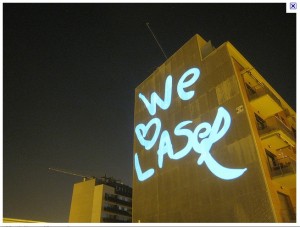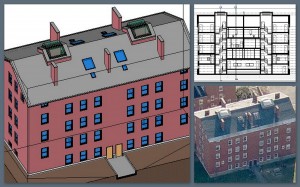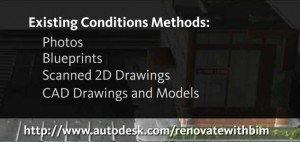Posts Tagged Existing Conditions
PointKnown cited in Autodesk Energy Modeling White Paper : BIM
Posted by Jim Foster in 3D, BIM, Built Environment, disto on June 29, 2011
 Autodesk has been concentrating on incorporating their energy modeling tools into their workflow, so much so, they are now calling it Rapid Energy Modeling and have outlined a variety of ways to capture a building’s geometry digitally so you can run it through their energy modeling engines. They outlined the following techniques/methods as the most cost effective for capturing exisitng conditions. Full paper available here: rem_white_paper_2011
Autodesk has been concentrating on incorporating their energy modeling tools into their workflow, so much so, they are now calling it Rapid Energy Modeling and have outlined a variety of ways to capture a building’s geometry digitally so you can run it through their energy modeling engines. They outlined the following techniques/methods as the most cost effective for capturing exisitng conditions. Full paper available here: rem_white_paper_2011
Digital photographs
These are photographs of your building taken specifically for rapid energy modeling.
Aerial images
You can download oblique aerial images from Internet sites such as Google Earth or Microsoft®Bing™ mapping services. Alternatively, you can use images from commercial providers of geo-referenced aerial and oblique image libraries such as Pictometry.
Satellite images
Like aerial images, you can download orthogonal images of your building from sites such as Google Earth. RAPID ENERGY MODELING FOR EXISTING BUILDINGS
Laser distance meters
These low-cost laser meters are common surveying tools, and you can also use them onsite to capture key measurements of your building.
PointKnown was cited as the software to use when utilzing laser range finders and capturing a building in revit.
If you plan to capture existing conditions using a laser distance meter, you can use PKNail software from PointKnown (www.pointknown.com) to process those measurements and create a Revit model of your building. By inputting a few simple field measurements PKNail will build a Revit model of the existing structure, in the field, in real time.
This approach involves trained survey personnel that walk around the perimeter of a building and measure key points on the building. The PKNail software utilizes Bluetooth®-enabled laser distance meters to capture dimensional data in the field and send it directly to a laptop loaded with the Revit Architecture or Revit MEP. By capturing data in a specific sequence, the PKNail software creates a Revit model representing the skin of your building as it is being measured.
While we wait for the ‘magic wand’ that digitizes existing buildings while you walk through it, and when I mean digitize, I mean scaled, architectural objects that can be scheduled, processed, etc. more and more technologies are being developed to speed the ‘realty capture’ of buildings. The argument for using PKNail is that the exterior model you build is natively in Revit Architecture and if you want to move inside for interior wall partitioning, etc. for adaptive reuse, etc. you can do that all by utilizing the key pad interface and the laser meter.
Not changing the world just making your day to day a little easier, increase productivity, get more accurate, teeing it up so you can knock it out of the park.
Laser to Revit : Laser to BIM : New Tools to Capture the Built Environment
Posted by Jim Foster in BIM, Built Environment, disto, Laser BIM, Revit on November 13, 2010
 With PointKnown’s introduction of PKNail and PPLT (Point to Point Laser Technology) utilizing a Leica Disto and Rand Technologies recent press release announcing the ability to manipulate and manage laser scan, point cloud data within Revit the opportunity and tools to capture existing conditions continues to grow. Combine that with the growing need to capture existing conditions for energy modeling and retrofits and you can see an industry emerging, not just using it for special circumstances but start capturing existing structures in 3D/BIM for uses that range from space planning, facility management, energy audits and beyond.
With PointKnown’s introduction of PKNail and PPLT (Point to Point Laser Technology) utilizing a Leica Disto and Rand Technologies recent press release announcing the ability to manipulate and manage laser scan, point cloud data within Revit the opportunity and tools to capture existing conditions continues to grow. Combine that with the growing need to capture existing conditions for energy modeling and retrofits and you can see an industry emerging, not just using it for special circumstances but start capturing existing structures in 3D/BIM for uses that range from space planning, facility management, energy audits and beyond.
While it has been reported and analyzed that some of the biggest frustrations, time sinks and expenditures is that lack of interoperability between software, and redundant efforts between disciplines, that is creating the same thing, many times for each discipline the advent of BIM authoring tools like Revit, and ways to combine and work with them can help firms and individuals reduce rework and create more opportunities for their design and construction work; looks like a win all around. And with these technologies firms can start on existing structures in BIM and Revit and have all the benefits.
Photofly : Real 3D from Photos : Cloud Computing Magic : #bim #cloud
Posted by Jim Foster in Autodesk, BIM, Existing Conditions, Laser Scanning, New Technologies on July 24, 2010
 While I have not taken this for a test drive yet the videos and technology behind this are impressive and could provide a very valuable tool set. First, a word about technology. Too many times software presupposes too much knowledge or interest on the user, that is this software can do some amazing stuff you just have to sit down with it, go through the manual, try and use it, sit in a classroom, hit the user groups, etc. to master it and make it a useful and successfully incorporate into your workflow. If you are like me you might be open minded to that but the benefits of learning a brand new software package have to be pretty amazing to entertain that process. Enter Photofly. From what I have pulled up and I included two videos here you upload standard digital photographs, which could range from your iphone to your 18 Megapixel Digital SLR, and Photofly does its magic in the cloud utilizing its own servers to render a photographic 3D image, that can be scaled using a known dimension to a dimensionally correct model that can also be exported to AutoCAD as a pointcloud. What?!$% From my perspective this is invaluable, and brings to the forefront technology that was only available from laser scanners. I am not saying this takes their place but any time you can put another arrow in your quiver for building surveying and documentation, the better. And if this is as intuitive as these 2 videos make it out to be, this is a home run.
While I have not taken this for a test drive yet the videos and technology behind this are impressive and could provide a very valuable tool set. First, a word about technology. Too many times software presupposes too much knowledge or interest on the user, that is this software can do some amazing stuff you just have to sit down with it, go through the manual, try and use it, sit in a classroom, hit the user groups, etc. to master it and make it a useful and successfully incorporate into your workflow. If you are like me you might be open minded to that but the benefits of learning a brand new software package have to be pretty amazing to entertain that process. Enter Photofly. From what I have pulled up and I included two videos here you upload standard digital photographs, which could range from your iphone to your 18 Megapixel Digital SLR, and Photofly does its magic in the cloud utilizing its own servers to render a photographic 3D image, that can be scaled using a known dimension to a dimensionally correct model that can also be exported to AutoCAD as a pointcloud. What?!$% From my perspective this is invaluable, and brings to the forefront technology that was only available from laser scanners. I am not saying this takes their place but any time you can put another arrow in your quiver for building surveying and documentation, the better. And if this is as intuitive as these 2 videos make it out to be, this is a home run.
Photofly Intro Video
Wrigley Field Gets Modeled From Tourist Photos
Revit As Built : Field BIM Technology : Build Digitally As You Measure : #BIM #Revit
Posted by Jim Foster in BIM, Laser BIM, New Technologies, Point to Point Laser Technology, Revit on July 2, 2010
It’s been a hau l and it starts with a quote from Irwin Jungreis one of the founders of Revit who I spoke to early in the process, ‘we never intended Revit to have an API,’ he said with a smile. ” It was supposed to be so good it would never need 3rd Party applications.” “WHAT?!” you say. I believe Irwin at the point understood the original hubris of that statement but then again I spoke to him after they sold out to Autodesk. “So what” we thought and we continued to forge ahead with an API that had as much horsepower as my old Puch moped. Thank you Autodesk for your continued efforts in beefing up the API but it has been a bear.
l and it starts with a quote from Irwin Jungreis one of the founders of Revit who I spoke to early in the process, ‘we never intended Revit to have an API,’ he said with a smile. ” It was supposed to be so good it would never need 3rd Party applications.” “WHAT?!” you say. I believe Irwin at the point understood the original hubris of that statement but then again I spoke to him after they sold out to Autodesk. “So what” we thought and we continued to forge ahead with an API that had as much horsepower as my old Puch moped. Thank you Autodesk for your continued efforts in beefing up the API but it has been a bear.
PointKnown is getting closer to releasing the commercial version of PKNail; it’s building surveying software. PKNail was programmed behind 7 years of building surveying experience. Our intention was to:
- Automate many of the rote tasks when creating existing conditions surveys of a building
- Create repeatable work flows
- Increase speed and accuracy by linking measurements directly into Revit
We understand surveying can be the bane of some people’s existence and it is a necessary evil to almost all projects, that is having accurate information to start the project. While we never considered it a bane or evil but when we would put on lunch and learns and dog and pony shows we usually got one of two reactions. One, where have you been my whole life I hate surveying or two, will you sell us the software because we do all our own measuring. We get it. And building in real time, in the field makes thing easier and building inside a familiar platform, and one that you will be designing or working in anyway makes you more productive right out of the box. I look forward to your feedback, comments we’re here to work with you. And to summarize my last statement in the video, ‘We’re much better at designing surveying software than making videos,’ but even comments on our production and lack of directing talents are welcome. Thanks for reading. – jim
Revit As Built : Field BIM : Existing Conditions
Posted by Jim Foster in BIM, New Technologies, Revit, Uncategorized on June 29, 2010
While I don’t usually take the time to pump my own gas with this blog I wanted to share the complete reversal in our deliverables over the last year. It used to be, way back at the end of 2008 that we delivered most of our building surveys in 2D AutoCAD format, now we would build in 3D, normally in ADT but our clients wanted 2D AutoCAD. From a surveying perspective a 3D object oriented universe worked better for us because essentially all the views were coordinated, that is build it in the floorplan directly, it is represented in elevation correctly. Anyone who has keyed up a plan in 2D knows where I am coming from, which if you are here reading this, means you know what I am talking about. Now, however, the bulk of what we do is deliver as-builts in Revit. The GSA requiring BIM has a lot to do with it, I believe, and Autodesk being the biggest player in the US means Revit becomes the default. Whether you like that or not does not matter, that’s the reality.
 Recently we have performed as built surveys at Phillips Exeter and Emmanuel College and we were field testing our laser to BIM technology, PKNail. It was created to capture typical conditions quickly and accurately. If you wanted to capture the Capitol Dome, I would suggest laser scanning, for capturing most situations Point to Point Laser Scanning (PPLT) should work just fine. PKNail converts measurements directly into a Revit workstation-wirelessly, measure a wall that wall is entered into Revit, encounter a door, window, Fire Extinguisher Cabinet, sink, if you can measure it, it can be placed quickly and easily into the model.
Recently we have performed as built surveys at Phillips Exeter and Emmanuel College and we were field testing our laser to BIM technology, PKNail. It was created to capture typical conditions quickly and accurately. If you wanted to capture the Capitol Dome, I would suggest laser scanning, for capturing most situations Point to Point Laser Scanning (PPLT) should work just fine. PKNail converts measurements directly into a Revit workstation-wirelessly, measure a wall that wall is entered into Revit, encounter a door, window, Fire Extinguisher Cabinet, sink, if you can measure it, it can be placed quickly and easily into the model.
Lastly, if the deliverable is 2D CAD, exporting views from Revit to AutoCAD sheets is a snap. Here’s a long winded Autodesk treatise on the subject or well, it looks like I will need to update with a screen capture video the quick process but the resulting CAD contains some of the meta information collected in 3D, such as 30″ Door, rather than creating anonymous objects. Next post will follow in short order with a sneak peak of some of the features and the connectivity between Revit and a Leica Disto enabled by PointKnown surveying software.
Thanks for tolerating some self promotion.
Capturing Existing Building Conditions Accurately and Efficiently
Posted by Jim Foster in Uncategorized on February 2, 2010
“Capturing existing building conditions accurately and efficiently is one of the keys to success for a renovation project.” That’s straight from the Autodesk video.
However, when they go over the methods for documenting existing conditions…
I’d like to add PKNail, because I would argue that it’s tough to be accurate without measuring something. Sure that’s a bit self serving, but we’ve all been there, dragging lines, using different colored pens, sketching with gloves on, or trying to use a laptop in the field, and we are fired up for the release, because it works, it’s making our job easier, we’re quicker, more accurate, and building Revit models in the field. measure –>press –>model and were eager to get it into everyone’s hands.
Public Beta Open in January : Capture as builts in Revit in the field: #Revit #BIM #asbuilt #laser #pplt
Posted by Jim Foster in As Builts, BIM, Built Environment, Existing Conditions, Laser BIM, Laser Scanning on December 16, 2009
We will be opening up our beta to public testing in January and we are asking for volunteers. Our product PKNail allows a user to use a hand held laser, Disto D8, and measure and build Revit models in the field. The measurements are transmitted via bluetooth to a mobile workstation which allows the user to quickly and accurately captures a building geometry and features. On board intelligence allows users to determine wall thicknesses, wall angles, toggle accuracy, attach notes to objects and more.
PKNail was developed by field surveyors and software engineers to help the AEC Community quickly and accurately capture a building’s geometry in Revit. This tool used alone of in conjunction with HDLS (High Definition Laser Scanning) can let you start any project in BIM / Revit. Proven ROI in as little as one project, and speed gains from measuring to model of over 200%.
With the majority of construction projects happening in the built environment, and in cities like Boston almost 80% done in the built environment start them in BIM and help everyone downstream.
This a powerful tool in capturing as builts in Revit and beta testers will be eligible for a substantial discount when purchasing.
info@pointknown.com
BIM As Built : Laser Technology
Posted by Jim Foster in As Builts, BIM, Laser Scanning, New Technologies, Revit on December 1, 2009
Speaking to a colleague from Europe who moved to the US because he stated, ‘there’s a survey shop on every corner in the UK, I could only find a handful here.’ However, that’s changing. HDLS, high definition laser scanning is starting to take off, especially now that the GSA issued the laser scanning awards. Additionally, more and more people are reworking existing assets / adaptive reuse projects so it is becoming more and more important to get the existing conditions data. While everyone is waiting for the day we can walk around with a magic wand and wave it around the room we have to build a bridge from here to there. HDLS in creating a 3D database is an excellent start. I believe HDLS, from firms like Leica and FARO, performs fantastically in certain circumstances such as inaccessible or difficult geometry, exposed MEP intensive projects, however, for typical conditions especially the interior of buildings it might be akin to using a sledgehammer rather when you need a fly swatter. We, PointKnown, have been developing a product that bolts on to Revit and takes laser range finder data and builds objects as you measure. This has been defined as PPLT (Point to Point Laser Technology). It allows a surveyor to move quickly and accurately from room to room or object to object. We do not intend for it to usurp laser scanning but rather augment current surveying teams, allowing them the most flexibility depending on the situation.
Most importantly is to define the deliverable and type of model needed for the project. This can start at the basic architectural model using generic library items to, well , anything goes but most of our clients want dimensionally correct space and then they apply the material and details they need as that is what they want to control.
We are now accepting people and firms into our public beta that starts January 2010, if you have any interest please feel free to contact us at info@pointknown.com and put beta in the subject line.
Revit Existing Conditions and As Builts Picking Up Pace : #BIM #Revit
Posted by Jim Foster in As Builts, BIM, Built Environment, Existing Conditions, GSA, Laser BIM, Revit on September 9, 2009
My company’s primary focus is to document existing conditions and deliver to the client ‘something’ dimensionally correct. This something has typically been 2D drawings, floorplans, elevations, sections, etc. We have utilized Revit on jobs that have required such extensive documentation that it was simply more efficient to create a 3D model and export the 2D data then document and draw the traditional way. In fact, we have documented existing conditions in 3D since 2003 because it was always simpler to be in and object oriented environment. However, the deliverables remained in 2D. However, almost everything we have done in the last 3 months has been Revit and delivering existing conditions building models in Revit. And the uses of the model vary widely.
- We surveyed and delivered a Revit model of two dormitories for a University in Revit, even though they did not have an installed seat, because they wanted to prepare for the future.
- We completed a Revit model of a single floor of Class A Office Space to be used for new interior layouts and design
- We are in the process of surveying and creating a model of a sprawling historic in built in parts starting with the main building in 1760 to a new hall built in 1984. This is to be used for master planning of the site which they will use for rendering and analysis and to integrate a new building that will house a new lobby and 50+ guest rooms.
So the uses of Revit are expanding, and even if they are not being used for 4D and 5D purposes its benefits for visual communication, analysis, and increased speed of design/drafting cannot be discounted. However, when integrating among all disciplines the results can be outstanding across the board.
We were fortunate enough to be part of the successful team, through a fantastic effort put forth by HNTB, that will be involved with the GSA and surveying and modeling their properties nationwide. What we have seen is either through the ripple effect or from other companies just being proactive that Revit and BIM are making a lot of headway into the community. Companies that we work with report that they hope to be doing all their projects in Revit by this time next year and with new ways of doing work, and changing workflow and even the environment comes opportunity.
40% of Energy Use Comes From Buildings : States Adopting Tougher Codes : BIM can help
Posted by Jim Foster in BIM, Energy Analysis, Revit, ROI on July 29, 2009
According to the EPA buildings are responsible for up to 40% of all energy usage and carbon dioxide production, because of the increasing need to decrease energy usage and the US carbon footprint more stringent building standards are being put in place based on ASHRAE 90.1-2007 with some states adopting stricter standards. Each state energy code is available here. Massachusetts had adopted one of the stricter standards and just wading through the stuff makes your head spin, I got sidetracked researching it by a thread discussing compliance concerning a sunroom and if it had to be added to the total exterior wall footprint of the house, and then there were tables with insulation factors, etc. To add to the madness there is the HERS (Home Energy Rater System) system developed through energy star, and the ResCheck Suite developed by the DOE that ‘helps’ with home compliance. Maybe you’ve started laughing by now or more likely crying. All of this is well meaning but will take even more specialists to wade through it, understand it and comply with it. Wouldn’t it be nice if there were plug in components for energy analysis with BIM software..wait a sec, they got that, and then run scenario analysis so you can see what modification or additions you need to make to comply to this new and evolving standards, have the software figure it out so you can design and build. Use a swiss army knife instead of a spoon.


